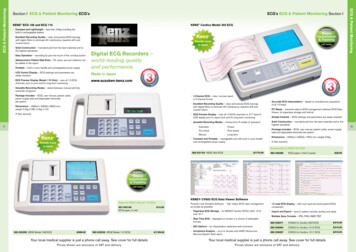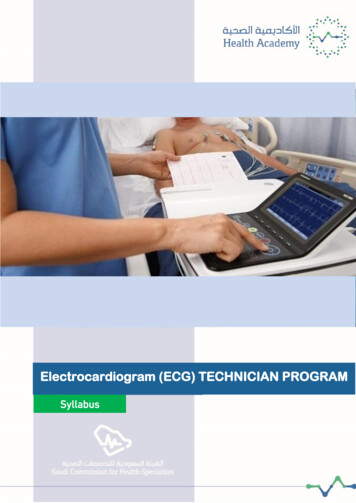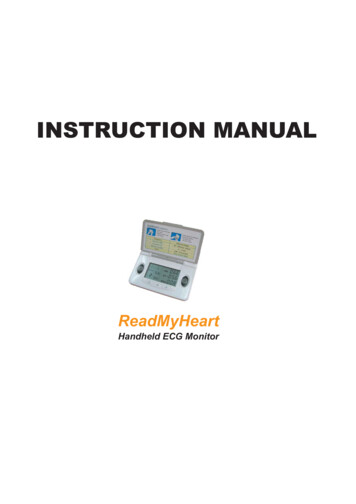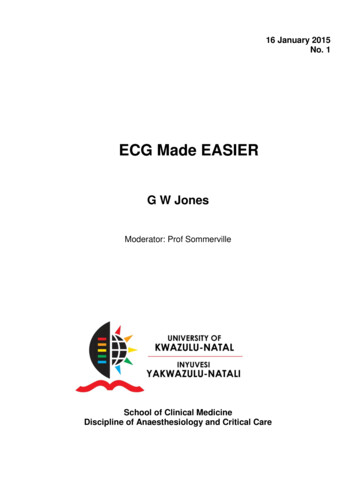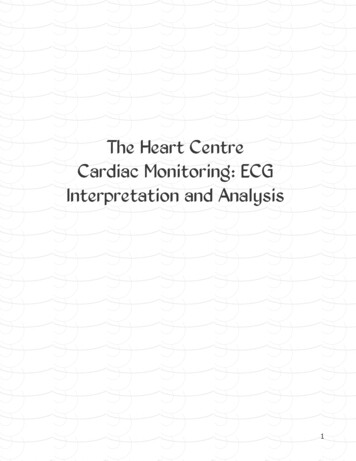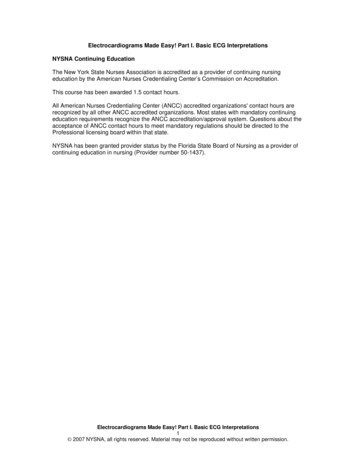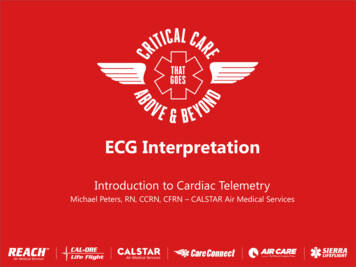
Transcription
Policies and ProceduresTitle: CARDIAC (ECG) MONITORING (ADULTS ANDPEDIATRICS)RNSP: RN ProcedureI.D. Number: 1142Authorization:[X] Former SktnHR Nursing PracticeCommitteeSource: NursingDate Reaffirmed: June 2018 roles updatedDate Revised: November 2016Date Effective: October 2004Scope: SktnHR - AcuteAny PRINTED version of this document is only accurate up to the date of printing 13-May-19. Saskatoon Health Region (SHR) cannotguarantee the currency or accuracy of any printed policy. Always refer to the Policies and Procedures site for the most currentversions of documents in effect. SHR accepts no responsibility for use of this material by any person or organization not associatedwith SHR. No part of this document may be reproduced in any form for publication without permission of SHR.DEFINITIONSCardiac monitoring, also referred to as ECG (electrocardiographic) monitoring, is defined as any ofthe following: Bedside monitors only (monitored by bedside nurse/physician)Bedside monitors with central monitoring occurring within the unit (monitored by bedside nurse)Telemetry with central monitoring occurring within the unit (monitored by bedside nurse)Telemetry with remote central monitoring occurring within the unit (monitored by centralmonitoring nurse)Telemetry with remote central monitoring occurring off the unit (monitored by central monitoringnurse)Certified bedside nurse: Registered Nurse in a targeted practice setting who has met certificationrequirements as described in policy statement 2.1.Telemetry: as a monitoring system attached to the patient which uses a wireless network to transmitECG data continuously to a centralized monitor location.Uncertified bedside nurse: includes both Registered Nurses and Licensed Practical Nurses.ROLESRegistered Nurses (RNs): RNs identified by their manager in targeted practice settings will be certifiedin the RN Specialty Practice (RN Procedure): ECG Monitoring and Rhythm Interpretation.1. PURPOSEPage 1 of 9
Policies & Procedures: Cardiac (ECG) MonitoringI.D. # 11421.1 To apply best practice standards to ECG monitoring to ensure prompt detection of changesin heart rate or rhythm.2. POLICY2.1 The RN certified in this RNSP will have first completed the following learning modules/activitiesprior to providing cardiac monitoring and rhythm interpretation independently: Attended an educational session on cardiac monitoring and rhythm interpretation Completed the learning package and quiz and returned to CNE Complete skills checklist with certified RN to validate and ensure safety checks arefollowed appropriately2.2 Physician order required Physician will order monitoring Physician will use appropriate approved forms to order monitoring.Example: if patient requires telemetry; recommended Telemetry Order Set (Appendix B) If ECG monitoring is a physician order, then an order to discontinue ECG monitoring(temporary or permanent) is also required. Units which utilize ECG monitoring may have unit specific standards pertaining to themonitoring requirements of that patient population. (i.e. PACU, ER, PICU, NICU, Acute CarePediatrics)2.3 Special Considerations ECG monitoring may be initiated by a certified nurse if it will assist in their clinicalassessment. If ECG monitoring is initiated by a certified nurse, it may be discontinued by the nurse, if theclinical condition is stable, unless there is a written physician order to continue ECGmonitoring. The Most Responsible Physician (MRP) or designate is responsible for decisions regarding thesignificance and treatment of identified arrhythmias. In a circumstance where the nurse is not certified in ECG Monitoring and RhythmInterpretation and bedside ECG monitoring is initiated by the physician, ECG monitoring isthe responsibility of the physician.3. PROCEDURE3.1 Initiating ECG monitoring:With bedside ECG monitoring the certified bedside nurse:3.1.1 Explains the purpose of ECG monitoring to the patient and family.3.1.2 Applies the electrodes to the appropriate location and attaches the correct cablesto each electrode. (See Appendix A).Note: Electrodes are to be changed q24hours and prn.3.1.3 Selects an appropriate Lead in which to monitor the patientPage 2 of 9
Policies & Procedures: Cardiac (ECG) MonitoringI.D. # 11423.1.4 Ensures that an acceptable ECG tracing is present3.1.5 Sets the appropriate alarm limits based on the initial rate / rhythm and ensures alarmsare set to the ON position.Note: Pediatrics- Alarms are set that are appropriate for the patient’s age or asordered by physician.With remote ECG monitoring the uncertified bedside nurse:3.1.6Explains the purpose of ECG monitoring to the patient and family.3.1.7Applies the electrodes to the appropriate location and attaches the correct cablesto each electrode. (See Appendix A)3.1.8Ensures that the central station is receiving an acceptable tracing3.1.9Communicates to certified central monitoring nurse the following: Patient identifiers (name, age, gender, medical record number)Patient room, unit and contact phone numberAttending MRPDiagnosis and reason for ECG monitoringRelevant history and medications3.1.10 Takes responsibility for ongoing surveillance of telemetry system integrityWith remote ECG monitoring the certified central monitoring nurse:3.1.11 Sets the appropriate alarm limits based on the initial rate / rhythm and ensuresalarms are set to the On position3.2Ongoing CareWith bedside ECG Monitoring the certified bedside nurse:3.2.1Checks the alarm limit settings at the start of every shift and continues to adjust thealarm limits as the patient’s rhythm and condition warrant.3.2.2Reviews every shift the monitoring trends and alarms. (If monitor capability exists)3.2.3Reassesses the patient for signs of hemodynamic compromise with any significantchanges in cardiac rate or rhythm (i.e. BP, oxygen saturation, respiratory rate, signsof myocardial ischemia etc.)3.2.4Reports to the MRP or designate 3.2.5Life threatening cardiac arrhythmias and initiates appropriate actions.Significant changes in cardiac rate and/or rhythmNew or unexpected changes in the cardiac rate, rhythm or clinical status.Ensures that temporary discontinuance of ECG monitoring during patient transfer fortests or personal care does not occur unless ordered by the MRP or designate.Page 3 of 9
Policies & Procedures: Cardiac (ECG) Monitoring3.2.6I.D. # 1142Reviews daily the continued requirement for ECG monitoringWith remote ECG monitoring the certified central monitoring nurse:3.2.7Checks the alarm limit settings at the start of every shift and continues to adjust thealarm limits as the patient’s rhythm and condition warrant.3.2.8Reviews every shift the monitoring trends and alarms. (If monitor capability exists)With remote ECG monitoring the uncertified bedside nurse:3.2.9Reassesses the patient for signs of hemodynamic compromise with any significantchanges in cardiac rate or rhythm (i.e. BP, oxygen saturation, respiratory rate, signsof myocardial ischemia etc.)3.2.10Reports to the MRP or designate Life threatening cardiac arrhythmias and initiates appropriate actions.Significant changes in cardiac rate and/or rhythmNew or unexpected changes in the cardiac rate, rhythm or clinical status.3.2.11 Ensures that temporary discontinuance of ECG monitoring during patient transfer fortests or personal care does not occur unless ordered by the MRP or designate.3.2.12 Reviews daily the continued requirement for ECG monitoring3.3Communication with telemetry and remote central monitoring3.3.1The uncertified bedside nurse communicates with the certified central monitoringnurse when: 3.3.2The certified central monitoring nurse communicates with the bedside nurse when: 3.4There has been a sudden change in the patient’s conditionThere has been a change in the patient’s cardiac medications, (i.e. new,discontinued or dose adjustment)The patient will be temporarily off telemetry or is returning from temporaryabsenceA report on the patient trends is requiredECG monitoring has been ordered discontinued.An acceptable ECG tracing is not being receivedA change from the patient’s baseline occursPotential life threatening arrhythmias occurNon-life threatening rhythms / rates occur that are a significant change fromthe previous monitoring trendsAdditional clinical information is required to clarify the significance of cardiacrate / rhythm changes noted.DocumentationPage 4 of 9
Policies & Procedures: Cardiac (ECG) Monitoring3.4.1I.D. # 1142The cardiac rhythm will be interpreted and documented in the patient chart at theinitiation of cardiac monitoring and at the beginning of every shift.Note: May use ECG Interpretation Strip (Appendix C)3.4.2All documented ECG strips must have the required patient identifiers and includethe date and time of the strip3.4.3All cardiac rates / arrhythmias which require immediate intervention must bedocumented in the patient’s chart.3.4.4Remote central monitoring by other than bedside nurse:3.4.4.1 Uncertified bedside nurse documents Verbal report given by certified central monitoring nurse at shift end andprn3.4.4.2 Certified central monitoring nurse documents on the telemetry record: Initial baseline rhythm strip and significant arrhythmias as they occurShift trends and significant events / treatmentsSends tracing documentation to unit daily (AM) and prnTimes of verbal communication with bedside registered or licensed nurse4. REFERENCESAehlert, B (2013). ECGs made incredibly easy. (5th edition). St. Louis: ElsevierDrew, B.J. et al. (2004). Practice standards for electrocardiographic monitoring in hospitalsettings: An American Heart Association scientific statement from the Councils onCardiovascular Nursing, Clinical Cardiology, and Cardiovascular Diseases in the Young:Endorsed by the International Society of Computerized Electrocardiology and the AmericanAssociation of Critical Care Nurses. Circulation Journal of the American Heart Association,110:2721-2746Huff, J. (2011) ECG Workout Exercises in Arrhythmia Interpretation. 6th Ed., Philadelphia:Lippincott Williams & WilkinsNovak, C, Gill, P. (2016) Pediatric Vital Sign Reference Chart. April 21, -reference-chartPage 5 of 9
Policies & Procedures: Cardiac (ECG) MonitoringI.D. # 1142Appendix AElectrode PlacementStandard Lead Placement – Five electrodesWhite – RABlack – LAGreen – RLRed – LLBrown – C right or left sternal border @ 4th intercostal spaceS- BlackA - RedI- WhiteN- GreenE- BrownEASI LeadLEADLead Color EASI Lead PlacementEbrownOn the lower sternum at thelevel of the fifth intercostalspaceAredOn the left midaxillary line at thesame level as the E electrodeSblackOn the upper sternumIwhiteNgreen*Ensure that the lead placement corresponds tothe ECG monitor configuration. (EASI or Standardlead placement)Incorrect placement will result in inaccurate ECGtracings.On the right midaxillary line atthe same level as the EelectrodeCan be anywhere, usuallybelow the sixth rib on the righthipNOTE: Make sure that the S and E electrodes line upvertically on the sternum and that the I, E and Aelectrodes align horizontallyPage 6 of 9
Policies & Procedures: Cardiac (ECG) MonitoringI.D. # 1142RALALLThree Lead SystemWhite- RABlack- LARed- LL (may be) OR Green-LL (PEDS)American Academy of Pediatrics : PALS provider manual 2006.Chest Lead Placement for (LifePak 15)Chest leads are in addition to thestandard three lead system,but includes a right leg (RL) lead as well.Page 7 of 9
Policies & Procedures: Cardiac (ECG) MonitoringI.D. # 1142Appendix BPage 8 of 9
Policies & Procedures: Cardiac (ECG) MonitoringI.D. # 1142Appendix CPage 9 of 9
3.4.4 Remote central monitoring by other than bedside nurse: 3.4.4.1 Uncertified bedside nurse documents Verbal report given by certified central monitoring nurse at shift end and prn 3.4.4.2 Certified central monitoring nurse documents on the telemetry record: Initial baseline rhythm strip and significant arrhythmias as they occur
